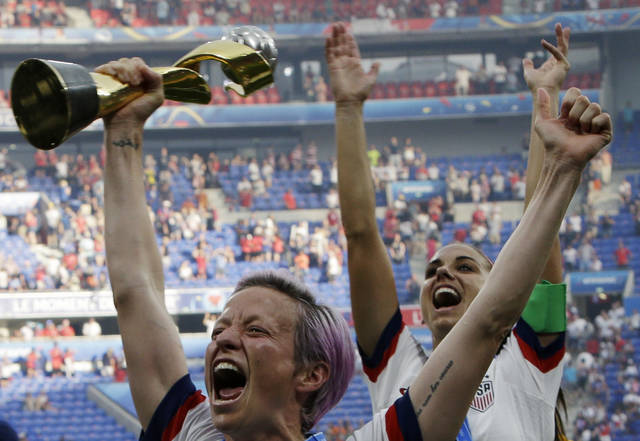Mark Madden: Women's soccer, especially in the U.S., worthy of more attention
The U.S. women’s national team won the World Cup, as expected.
Now, we forget about women’s soccer until the 2023 World Cup. Perhaps there will be a little interest for the 2020 Summer Olympics in Tokyo.
That’s a shame. Women’s soccer is worthy of more attention.
The nine-team National Women’s Soccer League has just two teams averaging attendance above 5,000 per game: Utah at almost 11K and Portland at a freakish 18,000-plus. Tickets sold might spike a bit in the wake of the U.S. winning. Budweiser just jumped on as a sponsor, and ESPN will televise 14 NWSL games between now and season’s end.
Both deals arrived after the NWSL season started and are directly derivative of World Cup hype.
The other odd by-product is on social media, where a significant amount of Americans seemed to be rooting against the U.S. in the final. That’s because of Megan Rapinoe’s feud with President Donald Trump.
That’s sad. But these women aren’t exactly America’s sweethearts, not do they try to be. That’s fine. To thine own selves be true.
The U.S. women won’t be visiting the White House. (But what if a few of them wanted to? Would they have the fortitude to speak up? Doubtful.)
Perhaps it’s time for no team to visit the White House. That’s regardless of who’s president. Let’s divorce sports from politics. This seems a good place to start.
The crowd in Lyon, France, erupted in chants of “equal pay” after the U.S.-Netherlands final.
That’s a two-pronged debate.
On the international level, France got $38 million for winning the men’s World Cup in Russia last year. The U.S. women will get $4 million for this victory.
But that World Cup in Russia generated $6 billion in revenue. The players got more than seven percent of that.
The 2015 women’s World Cup in Canada generated $73 million in revenue. The players got 13 percent of that.
Domestically, the U.S. women have a good argument for equal pay.
Between 2016-18, their games brought in more cash than the U.S. men’s games: $50.8 million to $49.9 million. Given the women’s success (and the men’s lack thereof), equal pay should be a fait accompli. Heck, the women deserve a little more than the men.
It’s all tied into revenue. You can’t go equal just for the sake of good PR.
The women’s game deserves more respect than it got Sunday. Two men’s finals were played the same day, namely the Copa America championship between Brazil and Peru, and the Gold Cup title match between the U.S. and Mexico.
FIFA sanctions all those competitions. That glut should have been prevented. The women should have had the day to themselves.
The women’s final once more showed the impact of replay.
Alex Morgan of the U.S. took a high kick to the shoulder from Dutch defender Stefanie van der Gragt while in the box. It was 0-0 in the 58th minute, and the referee either didn’t see it or let it go. Most refs would let it go in that situation. It didn’t egregiously prevent a scoring chance.
But when that decision went to replay, the foul couldn’t be ignored. It’s a high kick. The situation doesn’t enter into it. It’s a penalty.
Is that good? Is it bad? It’s a big change, that’s for sure.
Rose Lavelle of the U.S. put the result out of reach with a goal reminiscent of Liverpool’s Mo Salah charging forward. It was a magic moment and should be what’s remembered most about the U.S. victory.
But it probably won’t be. All the ancillary controversies have, in many respects, made the U.S. winning a second straight World Cup into a sidebar.
That’s because the U.S. women merely did as expected. That can be the curse of a dynasty.
Remove the ads from your TribLIVE reading experience but still support the journalists who create the content with TribLIVE Ad-Free.

